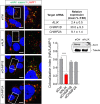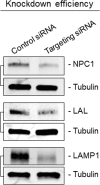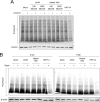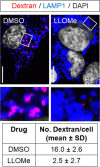Cellular entry and uncoating of naked and quasi-enveloped human hepatoviruses
- PMID: 30801249
- PMCID: PMC6422491
- DOI: 10.7554/eLife.43983
Cellular entry and uncoating of naked and quasi-enveloped human hepatoviruses
Abstract
Many 'non-enveloped' viruses, including hepatitis A virus (HAV), are released non-lytically from infected cells as infectious, quasi-enveloped virions cloaked in host membranes. Quasi-enveloped HAV (eHAV) mediates stealthy cell-to-cell spread within the liver, whereas stable naked virions shed in feces are optimized for environmental transmission. eHAV lacks virus-encoded surface proteins, and how it enters cells is unknown. We show both virion types enter by clathrin- and dynamin-dependent endocytosis, facilitated by integrin β1, and traffic through early and late endosomes. Uncoating of naked virions occurs in late endosomes, whereas eHAV undergoes ALIX-dependent trafficking to lysosomes where the quasi-envelope is enzymatically degraded and uncoating ensues coincident with breaching of endolysosomal membranes. Neither virion requires PLA2G16, a phospholipase essential for entry of other picornaviruses. Thus naked and quasi-enveloped virions enter via similar endocytic pathways, but uncoat in different compartments and release their genomes to the cytosol in a manner mechanistically distinct from other Picornaviridae.
Keywords: PLA2G16; endocytic trafficking; exosomes; extracellular vesicles; infectious disease; integrins; microbiology; picornavirus; virus.
© 2019, Rivera-Serrano et al.
Conflict of interest statement
ER, OG, AD, SL No competing interests declared
Figures





















Similar articles
-
TIM1 (HAVCR1) Is Not Essential for Cellular Entry of Either Quasi-enveloped or Naked Hepatitis A Virions.mBio. 2017 Sep 5;8(5):e00969-17. doi: 10.1128/mBio.00969-17. mBio. 2017. PMID: 28874468 Free PMC article.
-
Gangliosides are essential endosomal receptors for quasi-enveloped and naked hepatitis A virus.Nat Microbiol. 2020 Sep;5(9):1069-1078. doi: 10.1038/s41564-020-0727-8. Epub 2020 May 25. Nat Microbiol. 2020. PMID: 32451473 Free PMC article.
-
Biliary Secretion of Quasi-Enveloped Human Hepatitis A Virus.mBio. 2016 Dec 6;7(6):e01998-16. doi: 10.1128/mBio.01998-16. mBio. 2016. PMID: 27923925 Free PMC article.
-
Cell entry and release of quasi-enveloped human hepatitis viruses.Nat Rev Microbiol. 2023 Sep;21(9):573-589. doi: 10.1038/s41579-023-00889-z. Epub 2023 Apr 25. Nat Rev Microbiol. 2023. PMID: 37185947 Free PMC article. Review.
-
Hepatitis E Virus Entry.Viruses. 2019 Sep 20;11(10):883. doi: 10.3390/v11100883. Viruses. 2019. PMID: 31547135 Free PMC article. Review.
Cited by
-
Pathogenicity and virulence of hepatitis A virus.Virulence. 2021 Dec;12(1):1174-1185. doi: 10.1080/21505594.2021.1910442. Virulence. 2021. PMID: 33843464 Free PMC article. Review.
-
Phospholipase A and acyltransferase 4/retinoic acid receptor responder 3 at the intersection of tumor suppression and pathogen restriction.Front Immunol. 2023 Mar 31;14:1107239. doi: 10.3389/fimmu.2023.1107239. eCollection 2023. Front Immunol. 2023. PMID: 37063830 Free PMC article. Review.
-
Reovirus infection is regulated by NPC1 and endosomal cholesterol homeostasis.PLoS Pathog. 2022 Mar 9;18(3):e1010322. doi: 10.1371/journal.ppat.1010322. eCollection 2022 Mar. PLoS Pathog. 2022. PMID: 35263388 Free PMC article.
-
Integrin beta 1 facilitates non-enveloped hepatitis E virus cell entry through the recycling endosome.Nat Commun. 2025 Jun 26;16(1):5403. doi: 10.1038/s41467-025-61071-y. Nat Commun. 2025. PMID: 40571699 Free PMC article.
-
Point-of-Care Testing for Hepatitis Viruses: A Growing Need.Life (Basel). 2023 Nov 28;13(12):2271. doi: 10.3390/life13122271. Life (Basel). 2023. PMID: 38137872 Free PMC article. Review.
References
-
- Chen YH, Du W, Hagemeijer MC, Takvorian PM, Pau C, Cali A, Brantner CA, Stempinski ES, Connelly PS, Ma HC, Jiang P, Wimmer E, Altan-Bonnet G, Altan-Bonnet N. Phosphatidylserine vesicles enable efficient en bloc transmission of enteroviruses. Cell. 2015;160:619–630. doi: 10.1016/j.cell.2015.01.032. - DOI - PMC - PubMed
-
- Das A, Hirai-Yuki A, González-López O, Rhein B, Moller-Tank S, Brouillette R, Hensley L, Misumi I, Lovell W, Cullen JM, Whitmire JK, Maury W, Lemon SM. TIM1 (HAVCR1) Is not essential for cellular entry of either Quasi-enveloped or naked hepatitis A virions. mBio. 2017;8:e00969-17. doi: 10.1128/mBio.00969-17. - DOI - PMC - PubMed
Publication types
MeSH terms
Grants and funding
LinkOut - more resources
Full Text Sources
Research Materials
Miscellaneous

